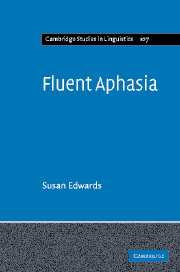Book contents
- Frontmatter
- Contents
- List of figures
- List of tables
- Acknowledgements
- Introduction
- 1 Fluent aphasia: identification and classic descriptions
- 2 Descriptions of fluent aphasia
- 3 Assessment and fluent aphasia
- 4 Connected fluent aphasic speech
- 5 Non-fluent and fluent aphasic speakers. What are the differences?
- 6 Comprehension and processing problems in fluent aphasia
- 7 The manifestation of fluent aphasia in one speaker
- 8 Some concluding thoughts
- References
- Index
4 - Connected fluent aphasic speech
Published online by Cambridge University Press: 22 September 2009
- Frontmatter
- Contents
- List of figures
- List of tables
- Acknowledgements
- Introduction
- 1 Fluent aphasia: identification and classic descriptions
- 2 Descriptions of fluent aphasia
- 3 Assessment and fluent aphasia
- 4 Connected fluent aphasic speech
- 5 Non-fluent and fluent aphasic speakers. What are the differences?
- 6 Comprehension and processing problems in fluent aphasia
- 7 The manifestation of fluent aphasia in one speaker
- 8 Some concluding thoughts
- References
- Index
Summary
Introduction
In this chapter we will discuss the nature of connected speech samples, their benefits and drawbacks and whether such data add to our knowledge of fluent aphasia. We will look at examples of connected speech, noting and examining errors that occur, and explore some possible explanations for them. The clinical descriptions of fluent aphasic speech that we examined in the preceding chapters concentrated on non-segmental and lexical features. We have also looked at supra-segmental features of fluent aphasia, observing that prosody is said to be normal while rate of speech is described as abnormal or, by some, hyper-fluent. However, we have seen that in a study where rate of speech was measured it was found to be normal. Lexical access is assumed to be deficient and this difficulty is associated with semantic and phonemic paraphasias as well as the production of neologisms. In terms of word-processing models, these errors suggest that deficits are at the semantic and phonological level of representation.
Many accounts of fluent aphasic speech have assumed that syntax is normal despite the fact that paragrammatism is a defining feature. However, there has been poor agreement over what paragrammatism is and it is debatable whether paragrammatism can be considered a syntactic deficit, despite the term. For most researchers, however, it is the ability to use well-formed sentences that defines fluent aphasia.
- Type
- Chapter
- Information
- Fluent Aphasia , pp. 92 - 121Publisher: Cambridge University PressPrint publication year: 2005



